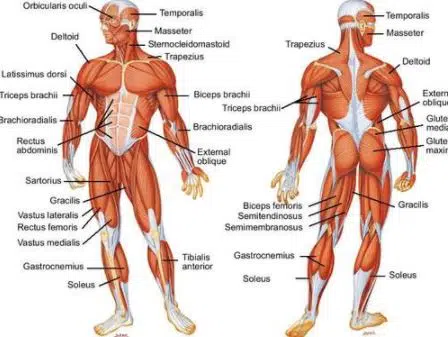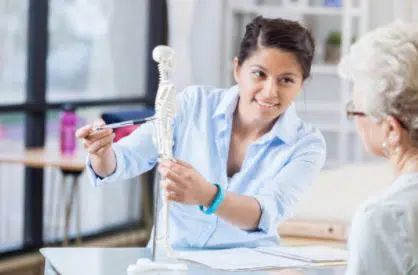In humans, muscles are involved in everything that we do, that is to say, they are central to how our bodies operate. They help us to move and maintain our body posture.
This article provides an insight into some of the common muscular system diseases that can cause weakness, severe pain and paralysis in extreme cases.
Muscular system
The muscular system is an organ system that consists of the skeletal, smooth and cardiac muscles. This system is responsible for the movement of the human body.
There are around 700 named muscles attached to the bones of the skeletal system that make up roughly half of a person’s body weight. Each of these is a discrete organ constructed of skeletal muscle tissue, blood vessels, tendons, and nerves.
Muscle tissues are also found inside other body organs including the heart, the digestive organs, and blood vessels. In these organs, the muscles move substance through the organs. There are three types of muscle tissue,
1. Visceral muscle
These are found in organs such as in the stomach, digestive tract, and in blood vessels. They are the weakest of all muscle tissue. They make the organs contract to allow ease movement of a substance through the organ.
These muscles are also known as involuntary muscle as they are controlled by the unconscious part of the brain. It is at times also described as smooth muscle due to the smooth uniform appearance. These muscles cannot be controlled by the conscious mind.
2. Cardiac muscle
Cardiac muscles are only found in the heart, they help pump blood throughout the body. They are also involuntary as such they cannot be controlled consciously.
Cardiac muscle stimulates itself to contract, however, hormones and signals from the brain adjust the rate of contraction. Because of its self-stimulation, these muscle is considered to be autorhythmic or intrinsically controlled.
The cells of the muscle are striated (they appear to have light and dark stripes). The arrangement of protein fibers inside of the cells causes these stripes. Striation indicates that cardiac muscle very strong.
3. Skeletal muscle
Skeletal muscle is the only voluntary muscle in the body. This means these muscle can be controlled consciously. Skeletal muscle is responsible for every action a person consciously does.
Most of these muscles are attached to two bones across a joint, for that reason, the muscle serves to move parts of these bones close to each other, this is what effects movements.
The muscle forms when many smaller progenitor cells lump together to form long, straight, multinucleated fiber. There are striated like the cardiac muscles making them very strong. They connect to the skeleton in at least one place hence the name skeletal muscle.
Just like with other parts of the body, the muscles can develop a disease that weakens the overall health of a person. These diseases can be caused by different conditions.
Generally, your risk of developing a muscular system disease is affected by your age, occupation, lifestyle, activity level and family history.
Injuries of the muscular system
Like other systems of the body, there are some injuries that might affect the way your muscular system functions. Some of the common such injuries will include the following:
- Sprain or strain, this involves stretching or tearing of a part of the muscle. A sprain is a tear of a ligament whereas a strain is a stretch of a muscle or tendon. A simple cold compress can help soothe the pain.
- Tendinitis which is the inflammation of the tendon as a result of chronic damage
- Splints, this is an injury involving inflammation of the muscle due to repetitive stress or muscle overuse.
- A cramp or muscle spasm which is a sudden muscle contraction after an activity or as a result of being dehydrated.
What diseases affect the muscular system?
Some of the common muscular system diseases include, but not limited to the following conditions:
1. Tendinosis
This condition occurs when a tendon becomes inflamed or irritated. Though common in the wrist, elbows, shoulder, and heels, it can occur in any tendon in a person’s body.
This condition is often characterized by mild swelling, pain, and tenderness. To treat it, one can use over the counter pain medication or prescribe medication. At home, a cold compress and relaxation will help ease the symptoms.
2. Mitochondrial myopathy
This is a neuromuscular disease mitochondria in the cells are damaged. Mitochondria are tiny structures in human cells that provide energy.
This condition can often be shown by symptoms such as muscles weakness, abnormal heart rhythm, blindness, and deafness. This condition can lead to droopy eyelids, vomiting, seizures, difficulty breathing and dementia
Currently, no specific treatment exists for this muscular disorder. Some supplements might help manage the symptoms of mitochondrial myopathy.
3. Myasthenia gravis
Myasthenia Gravis is a rare, chronic muscular disease that causes abnormal weakness in some muscles. It is caused by a defect in the neuromuscular junction and the delivery of nerve impulses to muscles. When this occurs, the brain no longer has control over the muscles.
Noticeable symptoms of this condition include drooping eyelids due to loss of muscle control around eyes. Other symptoms will include, difficulties breathing, loss of facial muscle control, shortness of breath, blurry vision among others
Treatment for this condition may include mediation and a surgical procedure.
4. Tetanus
Tetanus is a bacterial infection of the muscular system. It leads to painful muscle contraction which can interfere with your ability to breathe when affecting your jaw or neck muscle. There is no cure for tetanus.
With tetanus, you are likely to experience: painful muscle spasm, stiffness of neck muscle, difficulty swallowing,
Treatment for tetanus focuses on managing complications until the effects resolve. Vaccination against the condition reduces the risk of infection.
5. Cerebral palsy
Simply known as CP, this is a neurological disorder caused by an injury or trauma to the brain when the brain is developing. This can happen before birth, during birth or after birth. With this condition, every case is specific to those affected.
When caused by non-progressive brain damage, the condition causes impairment of motor function or complete loss in some cases. It can affect movements of a person body and coordination. Also, it can impact a person’s ability to speak and cause slight tremors.
The condition is permanent and incurable, however, there are some treatments and therapy that can help manage its effect on the body.
6. Dermatomyositis
This is a rare inflammatory disease affecting the skin and the muscle. It affects people of all ages and can be shown by symptoms such as difficulty swallowing, lung problem, abnormal weight loss, inflamed muscle, weakness, and muscle fatigue.
There is no cure for this condition but with medication, the symptom and progression of the disease can be controlled and managed.
7. Compartment syndrome
This is a painful condition where a significant amount of pressure builds in a person’s blood vessels, nerve, and muscle. This condition causes decreased blood flow, lack of nourishment and cutting off oxygen from reaching the muscle.
If untreated, those affected can become paralyzed. The condition can be treated with surgery.
8. Amyotrophic lateral sclerosis
Also known as Lou Gehrig’s disease, this is a serious neurodegenerative disease. The condition causes damage to the neurons which causes loss of control of voluntary muscle.
Early symptoms of this condition include difficulty breathing, speaking and swallowing. Paralysis is an advanced symptom of Amyotrophic lateral sclerosis
9. Rhabdomyolysis
With this condition, there is a rapid destruction of the skeletal muscle. The muscle fiber breaks down into myoglobin which gets extracted in urine.
Like other muscular disorders, this condition causes muscle weakness, severe pain, and stiffness. Treatment is effective when the disorder is detected at an early stage.
Rare and Genetic disorders in the muscular system
Genetic muscular disorders are caused by one or more abnormalities in the genome, most are present at birth, most of these conditions are rare, but hereditary, they are passed from the parent’s genes. In rare cases, defects can be caused by mutation or change in the DNA.
Here are common genetic muscular disorders:
10. Fibromyalgia
Fibromyalgia is a debilitating genetic muscular disease, causing pain and muscle stiffness and tenderness. This condition affects more women than men.
This condition can be associated with fatigue, memory loss and sudden change in mood. The condition has no cure. Relaxation and exercises can, however, help manage pain.
11. Muscular dystrophy
A muscular dystrophy is a group of muscle disease that progressively weakens the muscle. They cause damage to the muscle fiber and eventually cause loss of muscle mass.
The condition occurs when abnormal genes disrupt the production of protein needed for healthy muscle. Symptoms include muscle weakness, immobility, imbalance, difficulty breathing or swallowing.
12. Myotonia
This condition according to the National Institute of Neurological Disorders and Stroke causes the muscle to relax slowly after contraction or stimulation.
This condition can be caused by symptoms such as trouble releasing a grip on an object, difficulties walking or getting up from the chair. This condition often develops with time but can be inherited by an offspring.
According to NIND, treatment for this condition includes taking anticonvulsant medication to help manage the symptoms. Physical therapy may also be used in strengthening the muscle.
13, Stone man syndrome
Medically known as Fibrodysplasia Ossificans Progressiva, this is an extremely rare genetic disorder that occurs when soft tissue permanently hardens. With this condition, bone begins to grow between joints inhibiting any movements.
The condition is often misdiagnosed as cancer or fibrosis. Tumor-like lump form limiting speech, one is also likely to have breathing complications, and the condition can also become fetal with those affected not going past 40 years.
There is no cure for this condition but mediation and alternative treatment can be used to manage the pain.
Symptoms of muscular diseases
Muscle disorders can occur as a result of an injury, overuse, an infection, inflammation or genetic trait. In most cases, the disease can cause muscle pain, weakness and paralysis, these are often signs of serious muscular system disease.
For most people, muscular disorders are likely to affect the neck, shoulders, hips, wrist, back, knees and feet among other parts of the body. Other common symptoms will include the following:
- Severe recurrent pain
- Dull aches on the affected parts of the body
- Swelling and inflammation of body parts
- Stiff joints that restrict movements
- Limited range of motion
Treatment of muscular system diseases
Treating muscular disease is specific to a specific diagnosis. The treatment option used will also vary with the severity of the symptoms.
To relieve the pain, moderate exercise and over the counter pain medication can be used. In cases of more severe symptoms, your doctor may need to prescribe stronger medication to relieve pain and soothe inflammation.
Physical therapy or occupational therapy may also be recommended in some cases. When used, this therapies will help you learn how to manage pain and discomfort. They will also help you maintain your strength, range of motion and adjust to everyday activities.
Taking care of your body throughout adulthood can lower your risk of developing a muscular disease. This does not, however, mean that these diseases are inevitable, your risk of developing them increases with increase in age, as your muscles, bones, and joints naturally deteriorate as you age.
References:
- The muscular system: https://en.wikipedia.org/wiki/Muscular_system
- Muscular system, facts, function, and diseases: https://www.livescience.com/26854-muscular-system-facts-functions-diseases.html
- Common diseases of the muscular system: http://www.newhealthadvisor.com/muscular-system-diseases.html
- Musculoskeletal Disorders: https://www.healthline.com/health/musculoskeletal-disorders#overview1
- Muscular system Diseases: https://scienceaid.net/Muscular_System_Diseases
- Muscular system: http://www.innerbody.com/image/musfov.html#full-description


